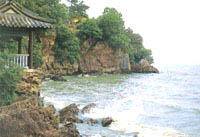 The water quality of China's third largest freshwater lake,Taihu Lake,is improving thanks to a project bringing water from the Yangtze River.
The water quality of China's third largest freshwater lake,Taihu Lake,is improving thanks to a project bringing water from the Yangtze River.
The project was launched on January 30this year, said Fang Lingdi, director of water resources protection bureau for Taihu Lake Basin under the Ministry of Water Resources.
"The project is not an emergency measure for instant achievements, but an important and long-term task for the comprehensive improvement of the lake's water quality and further protection of water resources and the ecological environment in the basin," Fang said Monday at an appraisal meeting on a report of water resources protection for Taihu Lake.
The project is focused on bringing clean water from the country's largest river, the Yangtze, to increase the lake's liquidity ratio, which is slow and not conducive to reducing pollutants in water, the official said.
According to statistics offered by the bureau's monitoring system on Taihu Lake's water environment, Wangyu River, the main channel for bringing water from the Yangtze to Taihu, has witnessed an improving water quality.
The average pollutant index has been reduced by 50 percent at least. Meanwhile, the quality level of the river's water has been improved from poor (level IV)or hazardous (level V)to slightly polluted (level III)or fairly good (level II). Moreover, the project has improved water resources in an area of 9,600square kilometers and benefited a population of 10million in the lake's neighboring cities Shanghai, Wuxi and Suzhou.
As a result of more water in the lake, quicker water flow in Taihu will promote ability for self-recycling and cleaning, the official pointed out.
"This is a positive step to water pollution control in the basin," she added.
With booming economic and social development, Taihu Lake basin, located at the center of the Yangtze River delta area in east China, has suffered from severe pollution and lack of water resources in recent years.
Quality of more than 80percent water in the lake-river network of the basin is lower than level III (slightly polluted).
Water pollution and enrichment of blue algae in the lake has lagged economic development in the area, said Suo Lisheng, China's vice minister of water resources.
The project is pouring abundant fresh water from the Yangtze River into Taihu Lake, thus diluting the dense portion of nitrogen and phosphorus in the lake water, which are major nutrition for the growth of blue algae.
According to the project, some 2.5billion cubic meters of water from the Yangtze River will be brought to the rivers and lakes in the Taihu Lake basin by the end of this year.
In the next few years, the annual water sum from the Yangtze River pouring into the area will be the same as this year.
In the area pouring with Yangtze water, the amount of blue algae reduced largely or disappeared completely.
But only via the project of water-bringing is not enough, Suo said, calling for effective control on pollution sources and diversified pollution-ban measures in the basin area. The project is diverting abundant fresh water from the Yangtze River into Taihu Lake, thus diluting the dense proportions of nitrogen and phosphorus in the lake water, which are major sources of nutrition for the growth of blue algae.
Some 2.5billion cubic meters of water from the Yangtze River will be brought to the rivers and lakes in the Taihu Lake basin by the end of this year.
In the next few years, the annual water flow from the Yangtze River into the area will be the same as this year.
In the area affected by Yangtze water, the amount of blue algae reduced largely or disappeared completely.
But the water diversion project was not enough, Suo said, calling for effective measures to ban water pollution at source.
In addition, diversified pollution control and water-saving programs should be carried out in the basin area, the official noted.
(eastday.com March 26, 2002)
